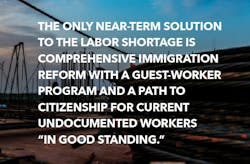Immigration Reform and the Leadership Gap
Nearly 13 years ago I published an article in Professional Builder titled “Lessons on the Road to Everywhere,” in the July 2004 issue. It was the story of an incredible man—an immigrant—I met while stuck in a massive Los Angeles traffic jam. He was my driver that day and his life story remains the single most remarkable I have ever heard. After his pilot father was killed, shot down by mistake while flying cargo to Israel during the 1967 Egyptian-Israeli Six-Day War, his newly impoverished mother had no choice but to disperse her children to live with relatives. Tesfaye, his Ethiopian name, found himself at age 13 indentured to a cruel uncle who treated him like slave labor on his farm in the Ethiopian bush. One night Tesfaye, then 15, carrying only what he could hold in his arms, began a six-month, nearly 2,000-mile journey on foot to Mombasa, Kenya, where he believed his late father had friends in aviation. His goal was to reach the United States, where an older sister had gone off to college before their father died. The problem was, he had no money, nor did he even have an address or phone number for his sister.
Just stop and imagine that for a moment. Age 15, no money and no map, walking the same distance as Chicago to Los Angeles, through infinitely tougher terrain and climates, not knowing who to trust, encountering different languages, severe hunger and desperate thirst, not to mention animals that would gladly consume you for lunch. Has even one of us reading this column taken on such an against-all-odds task … to get to America? Tesfaye made it and he did find help in Mombasa, which got him to Israel, then to Greece where, through tireless efforts, he eventually gained passage to the U.S. (And yes, he did it legally.) Fortunately, his Catholic school upbringing left him well-versed in English and Tesfaye had spent the last 30 years moving from place to place in the U.S., always working and sending money home to his mother, still in Ethiopia. He called it his “journey on the road to everywhere,” and due to his childhood journey, found he never was comfortable staying in one place for too long. This incredible man left a deep and lasting impression on me. I felt genuinely blessed to have been given the chance to learn from a remarkable soul born on the other side of the world.
Later on that trip I found myself on a jobsite marveling at the many languages I heard coming from faces that looked very different from mine, never drawing a moment’s recognition from any of the builder personnel I walked the sites with that day. The builders were wholly dependent on the hard work and industriousness of these immigrants, yet it seemed the workers didn’t exist, as everyone passed them with hardly a look. The day before, I may have reacted—or not reacted—in the same way. Now, however, with Tesfaye’s story on my mind, I couldn’t help but hear every accent, every language, see every face and wonder, what were their stories? I thought of football coach Barry Switzer saying, “Some people are born on third base and go through life thinking they hit a triple.” And, if we’re honest, the vast majority of us began on second base, at a minimum, just by growing up in the U.S. These immigrants working on our houses had to fight and sometimes risk their lives to even get up to bat against a horde of pitchers hurling one obstacle after another.
Stop. Listen. Learn.
The point of that July 2004 column was an appeal to stop, listen, and learn from the immigrants upon whose backs our industry depends. Learning their stories—and I’ve heard many more since—is incredibly inspiring. Whenever I hear a strong accent and there is enough time to listen, whether in a cab, at a restaurant, or on a jobsite, I love to ask, “Where are you from originally?” And if you ask in the right (nonthreatening) way, people open up with pride and tell you about their journey. Knowing a person’s history completely alters your perspective. Finding out these personal stories changes your attitude and feelings about virtually all immigrants. Perhaps it will even give you a glimpse of what some of your own ancestors suffered through to attain what, for most, was just a vague idea, a dream of a place called America. Will some naysayers hang onto their “immigrant go home” attitudes? Sure. Will still others continue to believe the false narrative that immigrants commit more crime than native-born citizens, when the facts prove otherwise? No doubt. Frankly, though, I no longer have time for those who define themselves by who and what they hate.
So how far have we come in the 13 or so years since I met Tesfaye? I spend more time travelling the country and walking jobsites than anyone I know, and perhaps 13 years ago I was quicker to pull at least some of my punches, but I’m too old and impatient for that now, so here is my completely forthright conclusion: Compared with 2004 when I wrote that column, as an industry we are more dependent today upon immigrant labor to build our houses than ever before. As a society, however, we have significantly regressed in our attitude toward immigrants and our treatment of them.
Everywhere you go there’s great suspicion of immigrant communities, and our recent elections have only served to fan those flames. Disinformation is everywhere. But one thing we in home building can’t deny is that without the immigrant community, we are dead in the water in terms of getting our houses built. If you happen to be in one of the few markets where immigrants don’t make up as high a percentage of the labor force, don’t for one second feel smug. If the immigrant labor in those other 95 percent of markets is threatened, the shortages in those markets will begin to pull the more traditional labor from your area within months. Count on it.
Can You Say, ‘The I Word?’
Things are beginning to happen in some cities to increase the trade base, and I’ve written extensively about those efforts in recent months. The full impact won’t be felt for years, however, and getting traditional high-school students interested in the building trades will never provide enough labor to annually build 1.5 to 2 million units. The only solution is comprehensive immigration reform with a guest-worker program and a path to citizenship for current undocumented workers in good standing.
When I last wrote about that, I got some pretty aggressive, even nasty email messages about how people “like me” are what’s wrong with this country. But as an editor pointed out to me when I started writing 20 years ago, “You haven’t made it until you win a Neal Award for your articles and get hate mail.” So check, and check, and many thanks. I was just nominated for another Neal Award, so just in case, I could use some hate mail to bolster my candidacy. Fire away.
George W. Bush understood the need for comprehensive immigration reform more than a decade ago, and got hung out to dry by his own party. Another workable proposal by a strong, fully bipartisan group of senators during the Obama administration similarly went down in flames. A hard look at our current crew in Washington, D.C., leaves me hard-pressed to say with any confidence that something meaningful will pass with this Congress. If anything, we appear to be going in the opposite direction, hell-bent on making immigration more difficult … unless.
What Does ‘Unless’ Look Like?
So what would the “unless” look like? I’ll put it as directly as possible. The home building industry, with its several major constituencies, needs to find the guts and fortitude to stand up and raise hell on the issue of immigration reform. It’s as simple—and as tough—as that. There are three groups, among others, that must tackle this challenge: NAHB representing all home builders, the NAHB’s Leading Suppliers Council, and the Leading Builders of America (whose members include most of the top 20 national builders).
I’ve thoroughly searched the NAHB website and all I can find is a one-page resolution, vaguely supporting immigration reform, published in 2004 and reaffirmed a couple of times thereafter. Further inquiries into specific lobbying efforts revealed nothing tangible. Clients of TrueNorth who participate in the Leading Builders of America, and a couple of those I know on the NAHB’s Leading Suppliers Council, say the issue of immigration reform has been discussed but that no definitive action has been proposed or launched. The NAHB executive team and all senior management from home building companies should need no convincing on why immigration reform must be at the very top of their agendas. And if the suppliers stop and think, the function and quality of their product once in the customers’ hands is largely dependent upon the quality of the installation, so it’s their issue as well.
What if this actually happened? Imagine if, starting next month, you began to hear that NAHB, Leading Builders of America, Leading Suppliers Council, and a host of other desperately interested parties were causing a genuine ruckus in Washington, D.C., on immigration reform? So much that it got coverage by Bloomberg, The Wall Street Journal, and TheStreet, among others. What if you kept getting requests to sign petitions and write your senators and representatives? What if your state and local HBAs teamed up to send delegations to Washington, insisting on in-person meetings with senators and representatives demanding action? What if the action got so intense that “certain parties” began to accuse our leadership of being among those trying to ruin America?
That would be a good thing, and damn the parties. Really, can we just set our ideological BS aside and do what’s needed for our industry? This, without question, is a bipartisan cause. Yet it can’t happen without focused, dedicated leadership. And your leadership won’t respond without you standing up locally and demanding it.
Home building is hardly the only industry dependent on immigrant labor. Others include hospitality, health care, senior care, agriculture, and food processing, for starters. These industries have similarly held back. It seems that everyone is afraid that by supporting immigration reform—and thus immigrants—they may be misinterpreted as supporting … what? Defending their industry? Securing their profitability? Could home building be the industry that inspires the others to jump in, with both feet, and start demanding in the very strongest terms that the U.S. Congress does its job?
The Dream
Just now John Lennon popped into my mind, “You may say I’m a dreamer, but I’m not the only one.” If that’s your conclusion—that this is just a dream—and you choose to sit back and let others solve your problems for you, that’s your right.
Yet my near-term dream goes like this: In the next month, along with the hate mail, I get a couple of hundred emails from companies, individuals, and associations laying out their specific plans to fight this fight and lead the charge. And if I hear from NAHB, the Leading Builders, and the Leading Suppliers that I’m not being fair and “just look at all we are doing!” then all the better. Maybe, just maybe, this industry will step up, grab this bull by the horns, and wrestle it to the dust. It’s time for all of us to show some leadership. Remember my friend Tesfaye. In Ethiopian, his name means, “my hope.”
About the Author

Scott Sedam
Scott Sedam is president of TrueNorth Development, a consulting and training firm that works with builders to improve products, process, and profits. A senior contributing editor to Pro Builder, Scott writes about all aspects of the home building business and won the 2015 Jesse H. Neal Award, business journalism's most prestigious prize, for his commentary in Pro Builder. Scott invites you to join TrueNorth's Lean Building Group on LinkedIn and welcomes your feedback at [email protected] or 248.446.1275.


